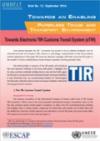Publications
Displaying Results 81 - 100 of 253
- English
The GHS addresses classification of chemicals by types of hazard and proposes harmonized hazard communication elements, including labels and safety data sheets. It aims at ensuring that information on physical hazards and toxicity from chemicals be available in order to enhance the protection of human health and the environment during the handling, transport and use of these chemicals.The GHS
- English
These recommendations have been developed in the light of technical progress, the advent of new substances and materials, the exigencies of modern transport systems and, above all, the requirement to ensure the safety of people, property and the environment. They are addressed to governments and international organisations concerned with the regulation of the transport of dangerous goods. The
- English
This brochure provides statistics on the main indicators for road, rail and inland waterways for countries in the UNECE region.The brochure is available for download in English.
- English
The European Agreement concerning the International Carriage of Dangerous Goods by Inland Waterways (ADN) done at Geneva on 26 May 2000 under the auspices of the United Nations Economic Commission for Europe (UNECE) and the Central Commission for Navigation on the Rhine (CCNR) has been in force since February 2008. The Agreement currently has eighteen Contracting Parties.The Regulations
- English
TIR and eTIR in the ESCAP regionUNECE, in collaboration with ESCAP, prepared a Policy Brief for the
- English
Adopted on 30 September 1957 in Geneva under the auspices of the United Nations Economic Commission for Europe (UNECE), the ADR entered into force on 29 January 1968. This authoritative Agreement is intended to increase the safety of international transport of dangerous goods by road. Its Annexes A and B contain the technical requirements for road transport, i.e. the conditions under
- English
The Manual of Tests and Criteria contains criteria, test methods and procedures to be used for classification of dangerous goods according to the provisions of Parts 2 and 3 of the United Nations Recommendations on the Transport of Dangerous Goods, Model Regulations, as well as of chemicals presenting physical hazards according to the Globally Harmonized System of Classification and Labelling
- English
This brochure provides statistics on the main indicators for road, rail and inland waterways for countries in the UNECE region. The brochure is available for download in English.
- English
ECE/TRANS/219, Sales No. E.13.VIII.2, ISBN 978-92-1-139147-3, Price: US$ 35, Languages: E, F, RThe Agreement on the International Carriage of Perishable Foodstuffs and on the Special Equipment to be Used for such Carriage (ATP) was done at Geneva on 1 September 1970 and entered into force on 21 November 1976. The
- English
These recommendations have been developed in the light of technical progress, the advent of new substances and materials, the exigencies of modern transport systems and, above all, the requirement to ensure the safety of people, property and the environment. They are addressed to governments and international organisations concerned with the regulation of the transport of dangerous goods. The
- English
The GHS addresses classification of chemicals by types of hazard and proposes harmonized hazard communication elements, including labels and safety data sheets. It aims at ensuring that information on physical hazards and toxicity from chemicals be available in order to enhance the protection of human health and the environment during the handling, transport and use of these chemicals.The GHS
- Spanish(西班牙语)
Content
The first section describes the TIR transit system, its coverage, objective and functioning and analyses possible future developments.
The second section contains the complete text of the TIR Convention.
The third section contains related resolutions and recommendations.
- English
Content
The first section describes the TIR transit system, its coverage, objective and functioning and analyses possible future developments.
The second section contains the complete text of the TIR Convention.
The third section contains related resolutions and recommendations.
- العربية
Content
The first section describes the TIR transit system, its coverage, objective and functioning and analyses possible future developments.
The second section contains the complete text of the TIR Convention.
The third section contains related resolutions and recommendations.
- Pусский
Content
The first section describes the TIR transit system, its coverage, objective and functioning and analyses possible future developments.
The second section contains the complete text of the TIR Convention.
The third section contains related resolutions and recommendations.
- Français
Content
The first section describes the TIR transit system, its coverage, objective and functioning and analyses possible future developments.
The second section contains the complete text of the TIR Convention.
The third section contains related resolutions and recommendations.
- 汉语
Content
The first section describes the TIR transit system, its coverage, objective and functioning and analyses possible future developments.
The second section contains the complete text of the TIR Convention.
The third section contains related resolutions and recommendations.
- English
The European Agreement concerning the International Carriage of Dangerous Goods by Inland Waterways (ADN) done at Geneva on 26 May 2000 under the auspices of the United Nations Economic Commission for Europe (UNECE) and the Central Commission for Navigation on the Rhine (CCNR) has been in force since February 2008. The Agreement currently has seventeen Contracting Parties.The Regulations
- English
Adopted on 30 September 1957 in Geneva under the auspices of the United Nations Economic Commission for Europe (UNECE), the ADR entered into force on 29 January 1968. This authoritative Agreement is intended to increase the safety of international transport of dangerous goods by road. Its Annexes A and B contain the technical requirements for road transport, i.e. the conditions under













